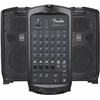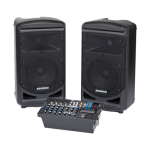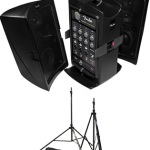What is FM Wireless?
To begin with, just what does FM wireless mean?
For starters, FM is one type of radio frequency transmission.
Webster’s Unabridged Dictionary tells us that radio frequency (RF) is a frequency in the electromagnetic spectrum within which radio waves may be transmitted, from about 3 kilohertz to about 300,000 megahertz.
What about IR Wireless?
Conversely, Webster goes on to state that infrared wireless (IR wireless) is electromagnetic radiation with wavelengths longer than visible light but shorter than radio waves.
Thanks for clearing up those definitions, Mr. Webster!
Which FM or IR Wireless System is Right for You?
The electro-magnetic wireless spectrum is wide and varied, even bewildering in its choices and applications. Moreover, with all the different types of FM and IR transmitters and receivers available, it’s easy to get confused about which wireless system is right for your particular needs.
Many factors come into play, such as coverage area, cost of equipment, even ease of use. However, the most basic considerations come down to these two:
1. How do IR wireless systems and FM wireless systems perform in different environments?
FM wireless systems provide a strong and reliable signal, which is able to pass through walls and opaque objects. It’s the most economical, simple-to-operate wireless system for churches, auditoriums, stadiums, classrooms and boardrooms. It even works well in the open air.
If your wireless system must function in large spaces, even on multiple channels, as a rule of thumb radio frequency systems are your best bet. This is especially true outside, where IR transmitters and receivers will often not function due to interference from sunlight.
Conversely, IR wireless systems are immune to radio interference. Receiver management is easier with infrared systems because there is no reason to search for the frequency.
With IR wireless listening systems, transmission is confined within opaque walls, making it a good choice for movie theaters, boardrooms, and courtrooms – anywhere privacy is valued.
IR wireless transmission also offers better fidelity much of the time, making wireless IR headphones a better choice for hi-fi applications like stereos and home theaters.
2. Is an IR or FM wireless system right for your application?
How secure does your wireless system need to be?
FM wireless systems have been unfavorably compared to IR in the area of security. FM systems are susceptible to interference and can be discreetly intercepted. The later has been a concern in high security situations — though it is important to note that current technology allows fairly sophisticated intercepts of IR signals as well (and also that encryption is improving on current FM wireless systems).
On balance neither system is fully secure — wireless transmission is by its very nature subject to intercepts — hard-wired systems are the only way to minimize this threat.
If you are looking for privacy within an enclosed space, then an IR wireless system is commonly considered the best way to go.
But in general, infrared systems are more costly and require more equipment to cover a larger area, and are also more difficult to set up – especially for applications that demand a more portable wireless system, such as for meetings that occur in different rooms of an office building.
To summarize, if you are looking for portability or there is a need for a wireless system that is easy to setup, then an FM system is your best choice.


